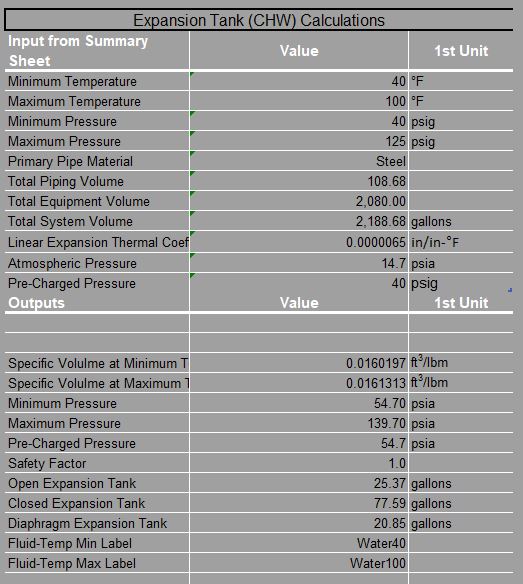
Engineering Pro Guides is your guide to passing the Mechanical & Electrical PE and FE Exams
Engineering Pro Guides provides mechanical and electrical PE and FE exam technical study guides, practice exams and much more. Contact Justin for more information.
Email: contact@engproguides.com
DESIGN
Expansion Tank Design Guide for Chilled Water Systems
Section 1.0: Introduction
An expansion tank is used in a chilled water system to accomplish three main tasks, (1) accommodate thermal expansion of the chilled water, (2) maintain positive pressure at all points in the system at all times and (3) maintain net positive suction head at the chilled water pump(s). There are other techniques and equipment besides the expansion tank that help to accomplish these three purposes, but only the ways the expansion tank affects these three purposes will be discussed in this guide. In addition, the three expansion tank types will be discussed, along with their sizing equations. The three types of expansion tanks are (1) open, (2) closed and (3) diaphragm. Finally design elements related to expansion tanks will be discussed, which include locating the expansion tank, tank materials, tank manufacturers and
The primary units that are used in the calculator are United States Customary System Units (USCS). As such, this guide focuses exclusively on the USCS. However, an SI version will also be provided in the future.
Section 1.1: Disclaimer
In no event will Engineering Pro Guides be liable for any incidental, indirect, consequential, punitive or special damages of any kind, or any other damages whatsoever, including, without limitation, those resulting from loss of profit, loss of contracts, loss of reputation, goodwill, data, information, income, anticipated savings or business relationships, whether or not Engineering Pro Guides has been advised of the possibility of such damage, arising out of or in connection with the use of this document/software or any referenced documents and/or websites.
This guide and calculator was created on the basis of the situations discussed within this guide. Although the intent was to create a calculator and guide that is applicable to all situations, there will be unique conditions where this calculator and guide do not apply. Please ensure that this guide and calculator is applicable to your situation.
Section 2.0: Overall Chilled Water System
This guide covers the design and selection of an expansion tank within an overall chilled water system. The expansion tank is a part of an overall chilled water system that often includes a chiller, piping, valves/fittings, chilled water pump, air handling units and fan coil units.
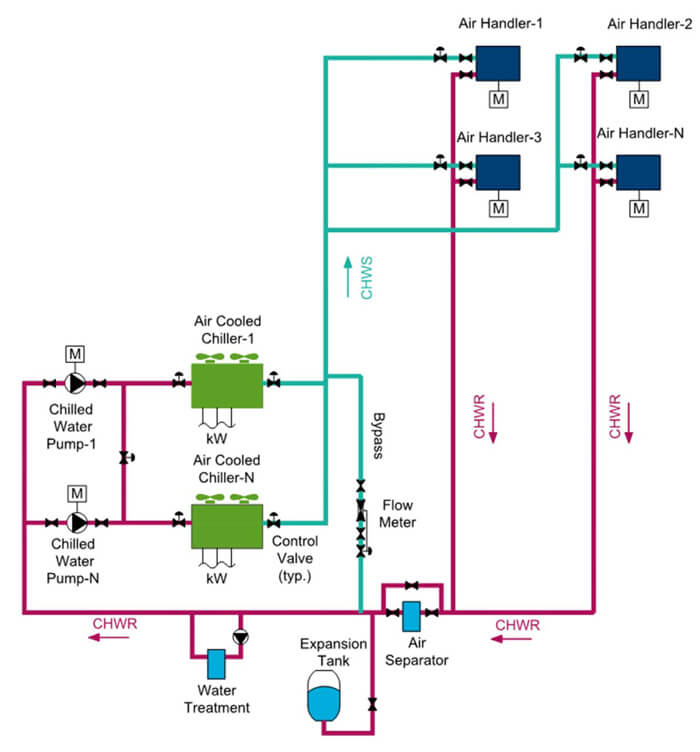
3.0 Expansion Tank Types
There are several types of expansion tanks provided by various manufacturers. However, there are only three main types for equation purposes. This section will take the major manufacturers and their expansion tank models and classify each model within one of the three expansion tank equations. The three main expansion tank sizing equations are (1) open tank, (2) closed tank with no bladder and (3) closed tank with bladder.
3.1 Open Tank
An open tank will most likely not be used in your HVAC system design, but it is shown here for completeness. An open tank consists of a large tank with an opening to the atmosphere. As temperature in the system builds, the fluid expands into the tank as shown in the figure below.

The open tank is typically located at the top of the system.
The open tank is governed by the below equation. The (v_2/v_1 -1) term describes the percentage change in volume of the system volume. The 3α∆t term describes the percent change in piping volume due to the expansion of the piping. This term is subtracted from the percent change in volume term because the pipe expansion will help to offset the expansion in liquid volume.

Please see section 3.4 for description of the variables and units.
3.2 Closed Tank with No Bladder
The closed expansion tank with no bladder does not have any openings to the atmosphere. It is simply a closed tank with a connection to the chilled water system. The closed tank has extra space that is filled with air, when the temperature in the system is cold. As the temperature within the chilled water system rises, the volume expands and fills the empty space within the tank.
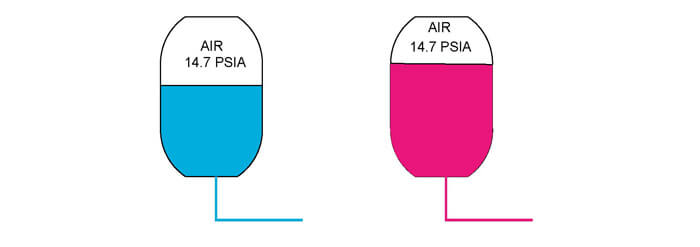
The equation that governs the closed tank is shown below. This equation follows the same basic format as the open tank, except that the constant “2” is replaced with the (P_a/P_1)-(P_a/P_2) term. This term describes the change in pressure that can be accommodated at the expansion tank. In the open tank, no pressure change can be accommodated. The open tank will fill as the liquid expands, but once the tank volume is filled, any additional volume will overfill the tank and no pressure change will be experienced. The closed tank on the other hand can accommodate an increase in volume and pressure. As the liquid expands the volume in the tank increases. Then, once the volume is filled, the closed tank will no longer increase in volume but will increase in pressure. This way the expansion tank can accommodate more liquid expansion with a lesser volume.

Please see section 3.4 for description of the variables and units.
3.3 Closed Tank with Bladder/Diaphragm
A closed tank with a bladder or diaphragm is the most common expansion tank. This expansion tank is similar to a closed tank, except within the tank there is a bladder or diaphragm that separates the water and the air. As the chilled water volume expands the water pushes against the bladder or diaphragm. The bladder or diaphragm serves as a barrier between the air and the water to limit the air that can be entrained into the water.
The bladder or diaphragm also allows the air within the bladder or diaphragm to be pre-charged or pressurized. The importance of pressurizing the air is that it determines the pressure that the chilled water must achieve before the expansion tank accepts volume. For example, the closed tank has a pressure of 14.7 psia. As the chilled water pressure increases above 14.7 psia, the chilled water will flow into the expansion tank. On the other hand, say the bladder/diaphragm is pressurized to 25 psig, then chilled water will only enter the tank when the chilled water exceeds 25 psig. This allows the closed tank with bladder or diaphragm to have a smaller volume because it does not need to accept volume at lower pressures.
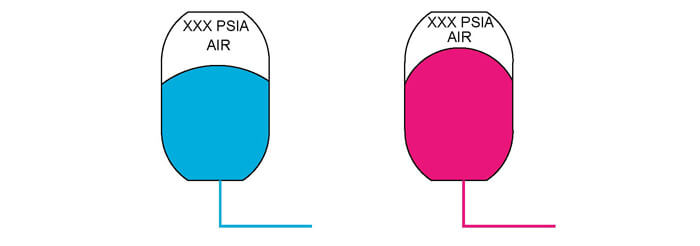
The basic equation for a bladder or diaphragm expansion tank with pre-charged air is shown below. The top term is the same as the closed expansion tank. The bottom term has replaced atmospheric pressure with P_pre, which is the pre-charged pressure.

Most often, the pre-charged pressure is selected to equal the minimum pressure in the system, P1. This reduces the above equation to the below equation.

3.4 Definitions of Equation Inputs
The following table lists all the variables used in the previous equations and provides descriptions and units for each variable based on USCS.
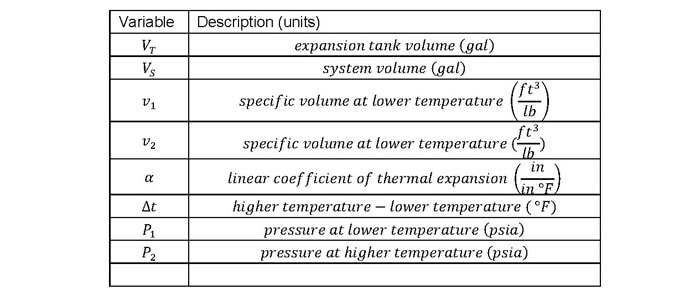
Section 4.0: Sizing an Expansion Tank
Once you select your expansion tank type, then you must determine the values to be used in the equation corresponding to the expansion type. Each of the variables will be discussed in this section, such that you can determine the values for each variable in a variety of situations.
4.1 DETERMINING TEMPERATURE VALUES
The temperature values are used to determine the “delta T” and the specific volume values discussed in the next section. You must find the lowest and highest temperatures that will occur within the chilled water system.

Low Temperature: The low temperature value is simply the chilled water supply temperature. The chilled water supply temperature range is constrained by the following two requirements. The chilled water supply temperature must be cold enough to dehumidify the air, but not too cold that the chiller freezes. The typical chilled water temperatures are shown below.
- Supply Chilled Water: 42 F to 48 F/5.56 C to 7.78 C
- Return Chilled Water: 52 F to 58 F/5.56 C to 7.78 C
If the chilled water system is a glycol mixture, then the lowest temperature may be different than what is shown above. Adding glycol to chilled water allows for lower chilled water supply temperatures, due to its lower freezing point.
High Temperature: The high temperature value is typically the temperature that occurs when the chiller and chilled water pump(s) are off. When the chilled water system is off, the chilled water can reach ambient temperatures. In a building with no air conditioning, the temperature can be in the 80 to 90 F range. If the chilled water piping is located outdoors, then the temperature of the chilled water can exceed 100 F, depending on the location.
4.2 DETERMINING SPECIFIC VOLUME VALUES
The specific volume values are determined from the liquid property data. The expansion tank calculator includes specific volume values for water and various polypropylene glycol and polyethylene glycol mixtures.

The specific volume values can also be found in ASHRAE Fundamentals for water and on the following website for glycol mixtures.
4.3 DETERMINING PRESSURE VALUES
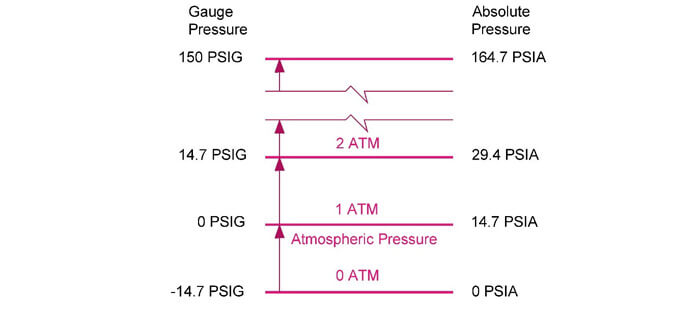
4.3.1 LOW/FILL PRESSURE
The low pressure is the minimum pressure at the system to achieve the most demanding requirement of the following two constraints, (1) 10 psig at the highest point in the piping or (2) net positive suction head required at the chilled water pump.
(1) Elevation Constraint: The low or fill pressure is the pressure required at the fill point necessary to fill the entire piping system and achieve 10 psig at the highest point in the piping to stop air from entering the water/solution. When calculating this pressure, you must assume the pump(s) is off and the temperature of the fluid is at its highest. The fill point is typically used because the expansion tank is located at the fill point and have nearly the same pressures. If the expansion tank is located away from the fill point, then you can use the elevation difference between the fill-point to find the minimum pressure at the expansion tank.
For example, assume the temperature of the fill water is 75 F and the water enters the system at an elevation of 10 feet above finished floor and the highest point in the system is 150 feet above finished floor. This will result in an elevation difference of 140 feet or 60.7 psig. Thus the fill pressure should be 70.7 psig. This example is illustrated in the first following figure.
(2) Net Positive Suction Head Constraint: Next, you should also check the net positive suction head required for the chilled water pumps. The low or fill pressure must be large enough such that the net positive suction head required is met.
For example, assume the temperature of the fill water is 75 F and the water enters the system at an elevation of 10 feet above finished floor and the highest point in the system is only 30 feet above finished floor. This will result in an elevation difference of only 20 feet or 8.6 psig. Thus, according to the previous constraint the minimum pressure will be only 18.6 psig. However, if the chilled water pump is located 10 feet above the fill point, then the pressure at the suction of the chilled water pump will only be 14.3 psig. If the pump requires a net positive suction head of 20 psig, then the fill pressure determined from the elevation constraint will not meet the net positive suction head constraint. Thus the fill pressure must be increased to meet the net positive suction head constraint. This example is illustrated in the second following figure.
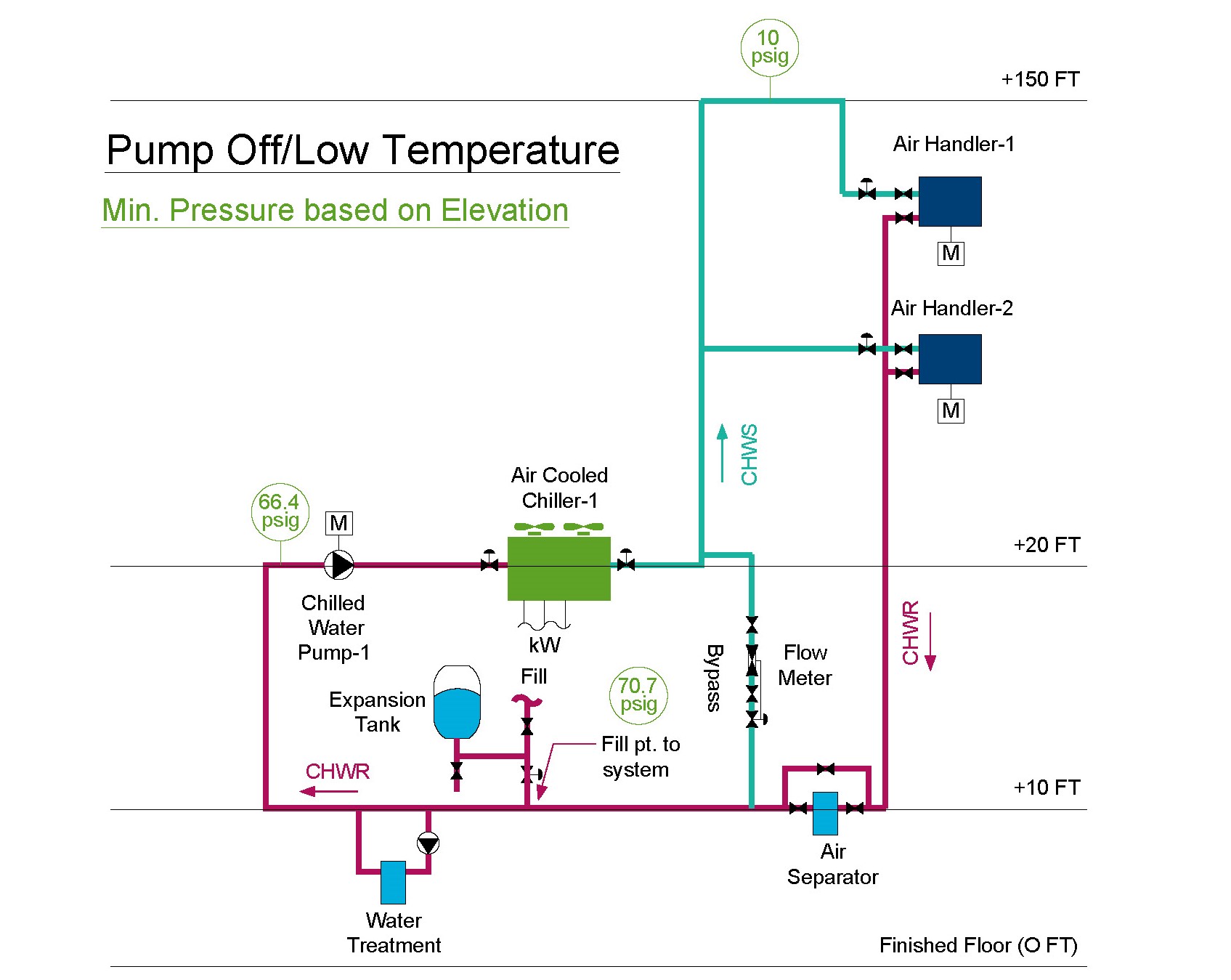
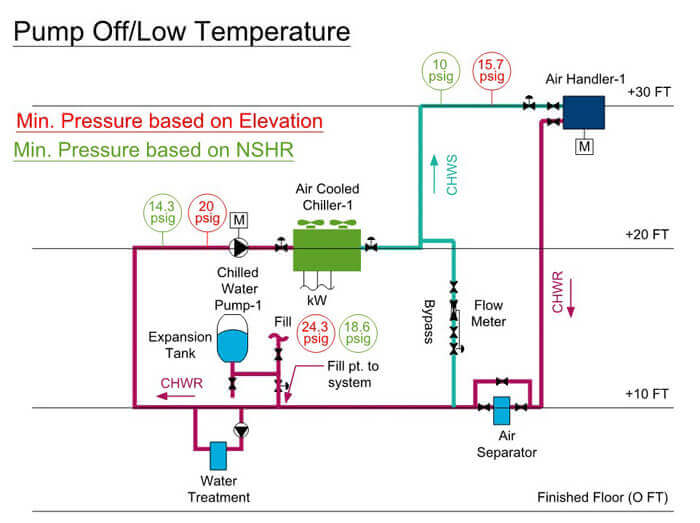
5.3.2 HIGH PRESSURE
The high pressure value is the highest pressure that can occur at the expansion tank such that no pressure relief valves or equipment failure occurs due to high pressure. The first scenario to check is with the pump on and the chilled water is at its highest temperature. Although this most likely will never occur in practice, it is a possibility and your design must be able to withstand the extreme possibilities. For example, assume the chilled water pump provides 40 psig and the chiller has a maximum pressure setting of 125 psig. You start at the chiller with 125 psig and then the suction of the pump will be 85 psig. Assume there are piping losses from the expansion tank to the pump of 4.3 psig. Then the expansion tank will have a high pressure of 80.7 psig.
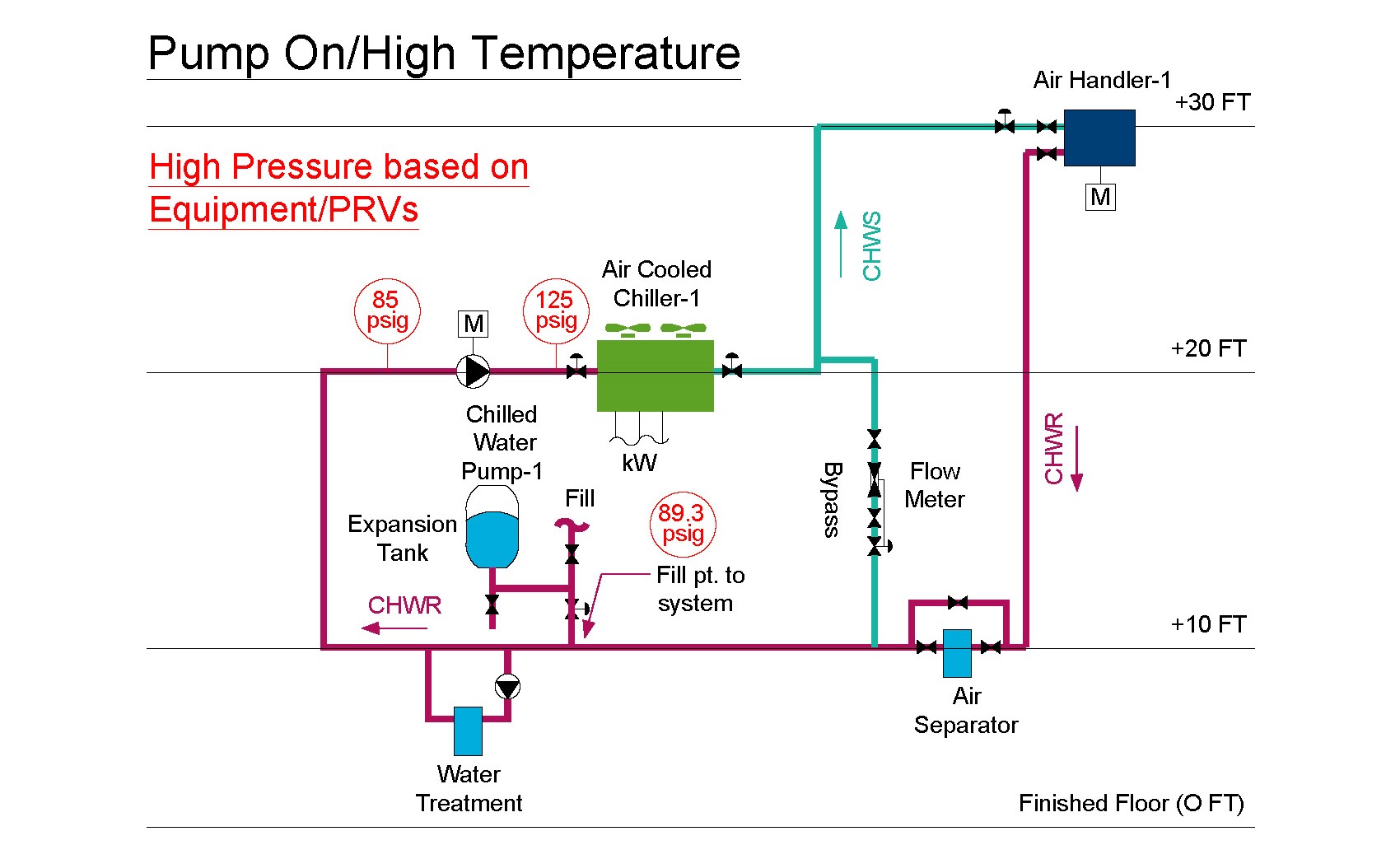
You should always run the scenarios with the pump on and off, because the equipment must be within the pressure requirements, whether or not the pump is on or off. For example, if you were to run a scenario with the maximum pressure at the fill point to the system as 125 psig, which is a typical maximum pressure for piping fittings, and the pump is off, then the pressure limits are met for all equipment. However, as soon as the pump is turned on, you will exceed the 125 psig requirement for the chiller.
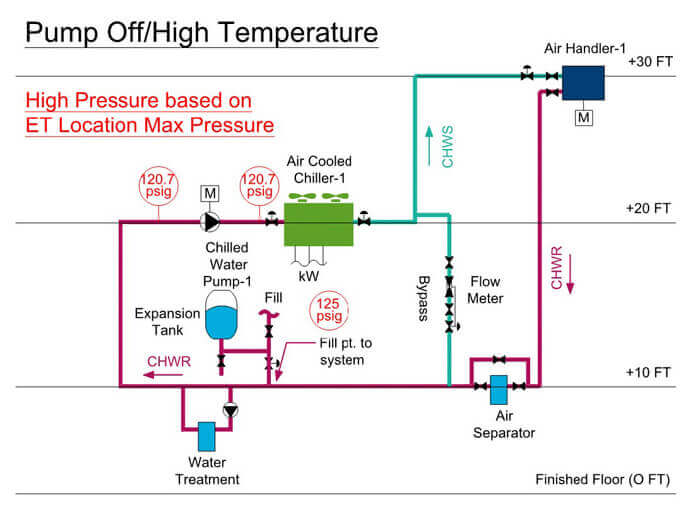

5.3.3 POINT OF NO PRESSURE CHANGE
Often times you will hear that the expansion tank is the point at which the pressure in the system does not change. This is true, but the assumption is that the temperature does not change. So do not get the previous discussion about the maximum and minimum pressures confused with the fact that the pressure at the expansion tank does not change when the pump is turned on or off. In fact, you can see that the pressure does not change when the pump is turned on and off in the previous figures, 8 & 9.
5.4 Linear Coefficient of Thermal Expansion
The following linear thermal coefficient of expansions can be used for your calculations. However, more accurate values can be achieved by using the data provided by the piping manufacturers.

If you have a mix of multiple pipe types, then you should use the lower coefficient of thermal expansion. This will result in a larger expansion tank. If you have a higher coefficient of thermal expansion then you will be taking advantage of the increased system volume that occurs when the piping expands. As the liquid heats up, the liquid expands, but the pipe also expands to accommodate some of the increased liquid volume. Thus, choosing the pipe material that expands the least will give the most conservative result.
Section 5.0: EXPANSION TANK DESIGN ISSUES
This section focuses on the most common design issues encountered when designing an expansion tank for a chilled water system. The issues include where to locate the tanks, what material to choose for the tank and what manufacturer to use for the tank.
5.1 LOCATING THE TANK
When locating the expansion tank you must check the pressures in the system, when the pump is on and off and when the system is cold or hot. The typical location for the expansion tank is on the suction line of the chilled water pump, near or on the fill line. Another possible location that is used less often is at the highest point in the system. The best way to understand where to locate the tank is to understand the implications of locating the tank in these two locations.
5.1.1 TANK LOCATED AT CHWP SUCTION
When locating the tank at the CHWP suction, near the lowest point in the system, the minimum and maximum pressures will be much higher than the tank at the highest point. This is because the lowest point will have the pressure from the elevation acting upon this point. In the following diagram, it is assumed that the minimum temperature is 40 F and the maximum temperature is 100 F. The maximum and minimum pressures are found based on the elevation difference and a pump that provides 40 psig of pressure. In addition the total chilled water volume is 2,100 gallons and the expansion tank is a diaphragm type tank. This results in a tank of 104 gallons.
The benefits of locating the tank at the CHWP suction are that the expansion tank is typically easier to maintain near the pumps and chillers. The pumps and chillers are located at the ground floor in a mechanical room because it is too difficult to maintain equipment on the roof and too difficult to replace equipment on the roof.
As you may remember, the tank location is a point of constant pressure when the pump is turned on and off, assuming temperature remains constant. Thus, the tank is typically not located on the discharge side of the pump because this means that regardless of when the pump is turned on or off, the discharge of the pump will have the same pressure. Basically, when the pump is turned on, the pressures throughout the chilled water system are reduced as opposed to increased.

5.1.2 TANK LOCATED AT HIGHEST POINT
When the tank is located at the highest point, the maximum and minimum pressures will be lower. If all other variables are held equal and only the maximum and minimum pressures are changed, the expansion tank will need to be 39 gallons. As you can see, locating the tank at the higher point with the lower pressures will result in a smaller tank. The disadvantages are the maintenance issues with repairing and replacing a tank at the highest point in the chilled water system.
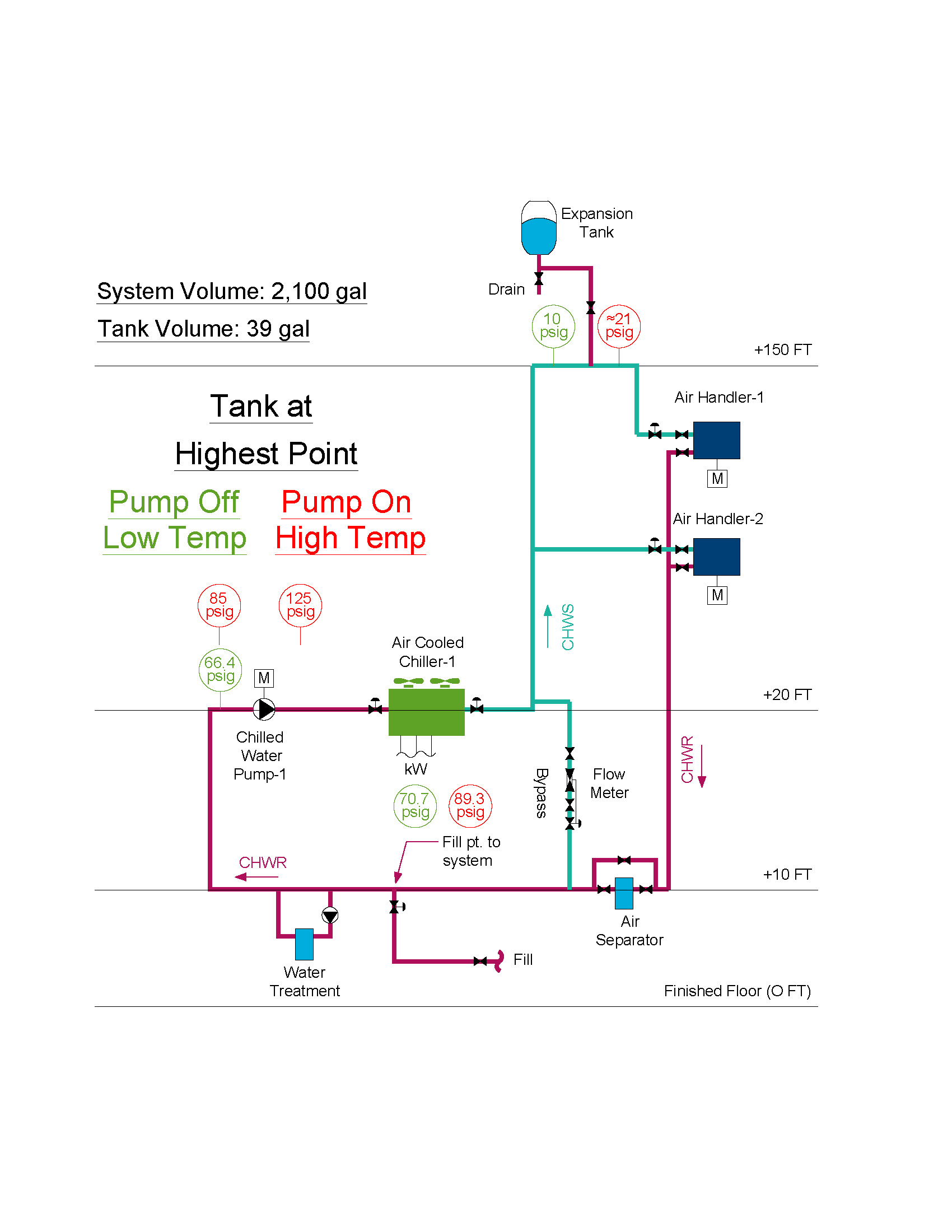
5.2 TANK MATERIALS
When selecting an expansion tank, you must first select the type and then the size. Following these choices, you must next select the tank material.
Shell: The shell of an expansion tank should be ASME certified and should also be capable of withstanding the pressures within the system. Typically the shell is rated for 150 psig and most shells are steel.
Diaphragm/Bladder: The diaphragm/bladder should be suitable to withstand the corrosiveness of the air/water or glycol. Since the chilled water is typically not used for potable water, the diaphragm/bladder does not need to be approved for handling potable water. The material of the diaphragm/bladder is typically a plastic like polypropylene or a rubber like butyl.
5.3 TANK MANUFACTURERS
Manufacturers that provide this type of expansion tank are shown in the table below. The last time this table was updated was in January 2018. Manufacturers may have changed the information below.
Manufacturer (Make) Website
- Amtrol: https://www.amtrol.com/product/therm-x-trol-expansion-tanks/
- Flexcon: https://www.flexconind.com/products/category.html?newsid=62
5.4 ANCILLARY DEVICES
An expansion tank has the following typical ancillary devices that help to support the function of the expansion tank.
Shut-Off Valve: A shut off valve should be provided on the system connection between the chilled water system and the expansion tank. The shut-off valve allows you to disconnect the expansion tank so it can be repaired or replaced.
Drain Valve: In order to repair the tank, the water must be drained from the expansion tank. Thus a drain valve should be provided on the tank or on the piping leading to the tank. The drain valve should be at the lowest point of the tank and should be in-between the shut off valve and the expansion tank.
Air Valve: The air valve is used to charge the bladder/diaphragm expansion tank types with compressed air.
Supports: The expansion tank should be supported by either hanging it from the ceiling or wall or floor supported. The expansion tank should not be supported by the piping.
Section 6.0: EXPANSION TANK DESIGN ISSUES
6.1 FLUID INPUTS
In this section you will input the temperature range and pressure range for the fluid. In addition, you must also specify the fluid as 100% water or a mixture of water and glycol.
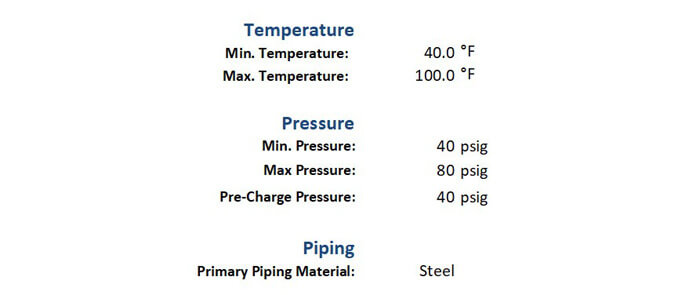
6.2 PIPING INPUTS
In the piping section, you must input all chilled water pipes into the table. All lengths of pipes must be encountered for in this section. The piping along with the equipment will determine the total system volume.

6.3 EQUIPMENT INPUTS
Next, you must input all equipment into the table and the volume of chilled water within each piece of equipment. The chilled water equipment volume along with the piping volume will determine the total system volume.

6.4 EXPANSION TANK OUTPUTS
Using the total system volume and the fluid inputs, the calculator will automatically and instantly output the sizes of the three types of expansion tanks (1) open, (2) closed and (3) closed with diaphragm/bladder.
